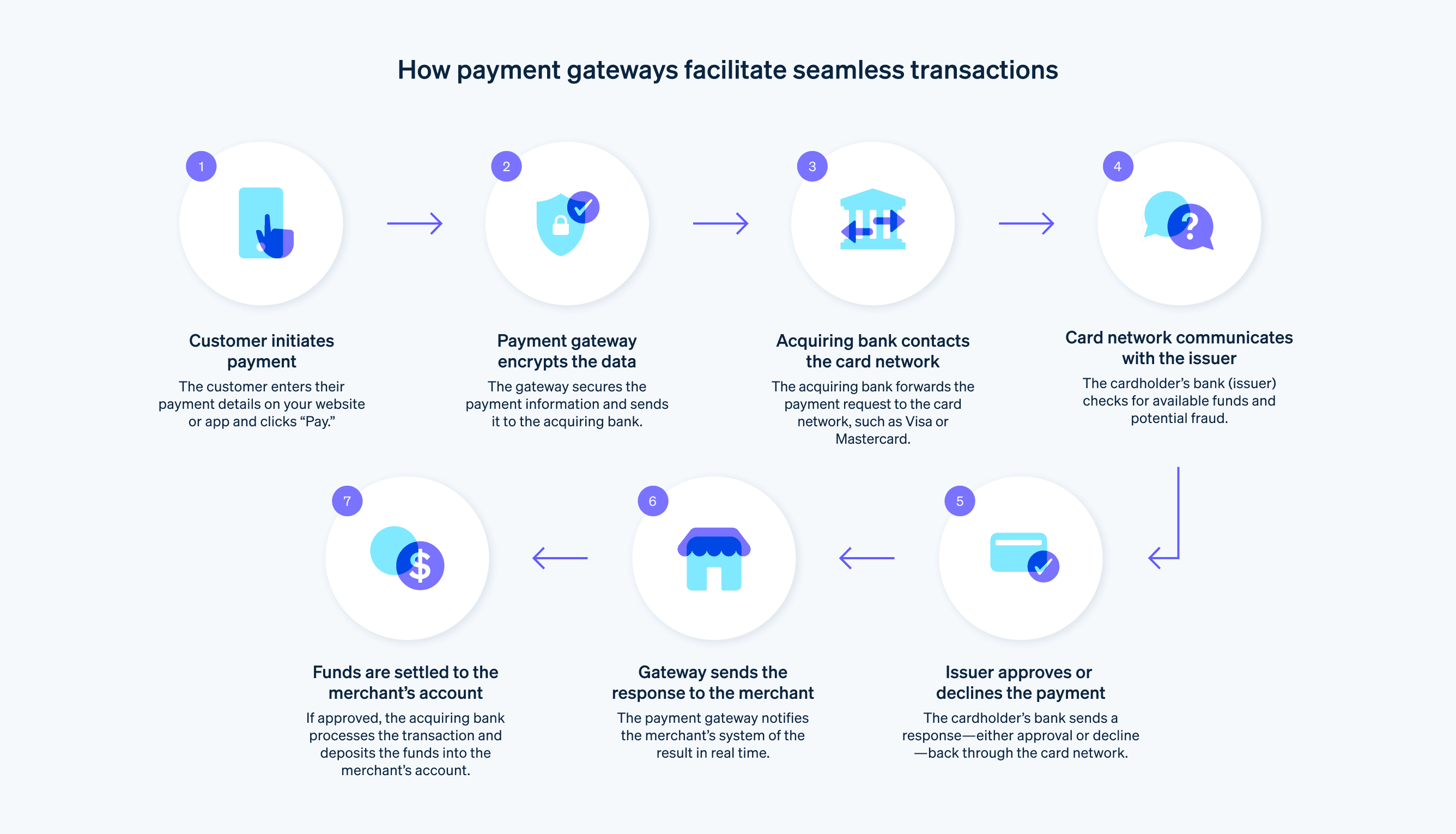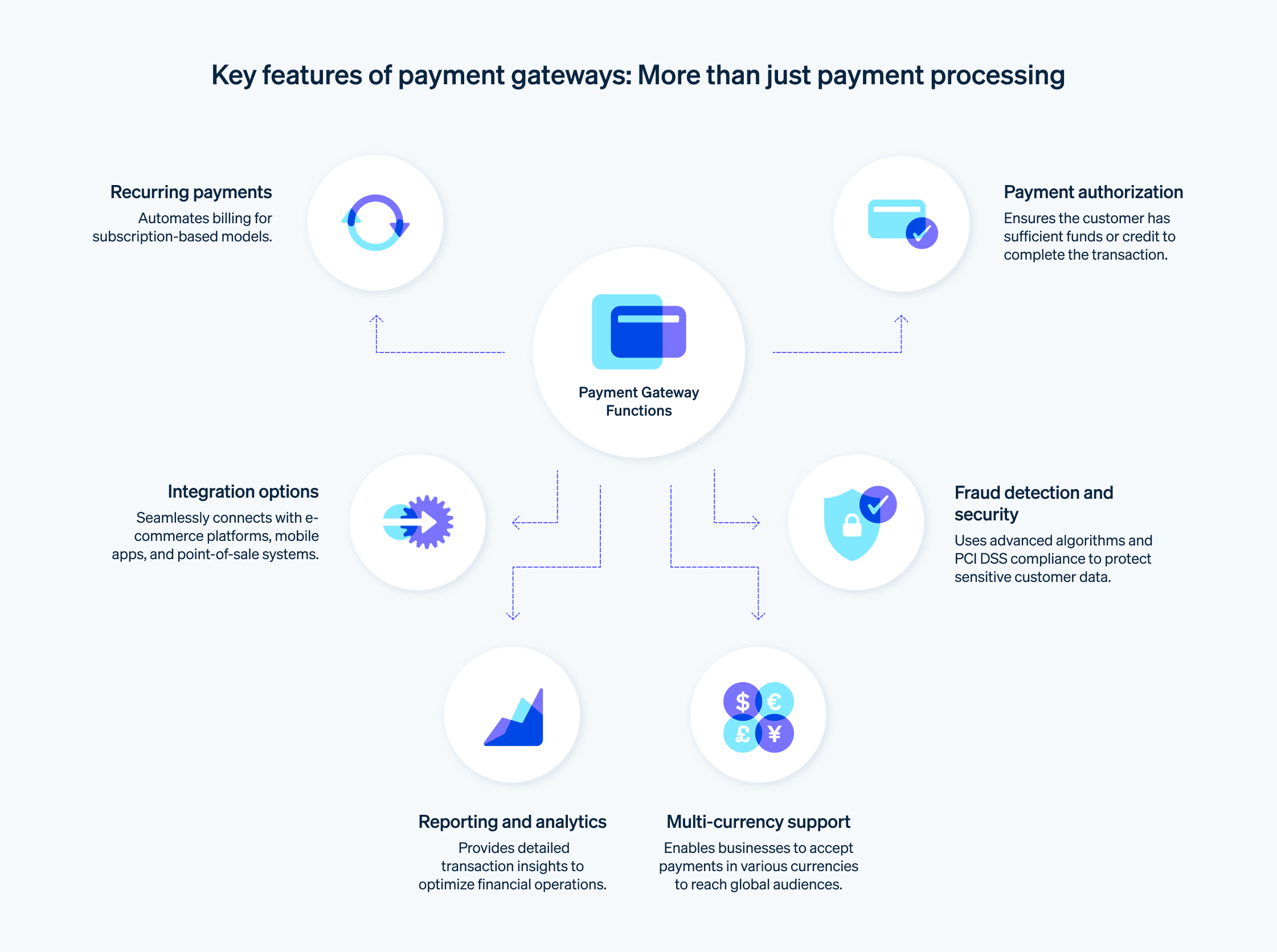预计到 2032 年,支付处理市场的价值将达到约 1980 亿美元,与 2022 年的 656 亿美元估值相比大幅增长。这凸显了简单、有效和安全的支付处理解决方案对于接受线上付款的企业的重要性。
随着客户对多样化支付方式和流畅支付体验的期望不断提高,企业正在评估越来越多的支付处理选项。有些人正在考虑是否应该创建自己的支付网关。通过开发这种定制解决方案,企业可以更好地控制他们的交易,改善客户体验,并降低交易成本。但是,创建支付网关的过程很复杂,需要仔细规划和执行。
以下是创建自己的支付网关的指南,可帮助您更好地了解要求、优势和潜在挑战。
目录
- 什么是支付处理商?
- 什么是支付网关?
- 支付网关如何工作?
- 支付处理商如何工作?
- 开发自己的支付网关的好处
- 构建自己的支付网关的障碍
- 如何创建自己的支付网关
什么是支付处理商?
支付处理商是由企业指定的金融实体,负责处理信用卡和借记卡交易。这个角色对于线上和线下接受银行卡支付的电商 企业的运营很重要。
支付处理商协助传递交易信息。然而,它们的作用不仅仅是传递信息。支付处理商还提供其他服务,帮助企业保护、验证和简化银行卡交易。
什么是支付网关?
支付网关是一种技术,供企业用来接受来自客户的银行卡和数字钱包 付款。该术语不仅包括实体零售店中的实体读卡器,还包括负责电商、移动商务 和其他无卡 (CNP) 交易支付流程的线上读卡器。
支付网关为交易过程 中涉及的各种组件之间的通信提供便利。他们将信用卡信息从企业网站发送到信用卡支付网络 进行处理,并将交易详情和响应从支付网络返回给网站。
支付网关如何工作?
支付网关和处理商充当企业和客户之间的中介,确保每笔交易都安全及时地进行。该过程通常包括几个步骤,从客户支付商品或服务款项开始,到企业收到付款结束。
支付网关在交易过程中有几个重要的职责,包括:
加密
当客户下订单时,网关对支付信息进行加密,然后再将该信息发送到企业的 Web 服务器。从那里,网关将交易数据发送到企业的收单行 使用的支付处理商。填写订单
然后,处理商将与企业和客户相关的授权转发到支付网关。网关获得此响应后,就会将其传输到企业的网站(或处理付款的任何接口)以完成付款过程。如果交易获得批准,企业就可以履行订单。结算
在一天结束时,企业将一批全都获批的授权发送给其收单行进行结算。银行将批准的资金总额存入企业的指定账户。这可以是每天、每周或其他商定的时间表。
通过在客户、企业和支付处理商之间提供安全的途径,支付网关可确保顺畅、安全和快速的线上交易。支付网关还采用各种安全措施,例如 SSL 加密和欺诈预防工具,以保护敏感数据(如信用卡号和其他个人信息)。

支付处理商如何工作?
“支付处理商”和“支付网关”这两个术语有时可以互换使用,但它们代表了支付周期中的两个不同阶段。以下是对每个术语的更详细阐释:
支付处理商
支付处理商是与企业合作处理收单银行交易的公司。当客户使用信用卡或借记卡支付产品或服务时,支付处理商会立即执行以下几项任务:
授权
它会验证信用卡的详细信息(例如该卡是否已失效),并检查客户是否有足够的信用额度来支付购买费用。交易流程
授权后,支付处理商将处理交易。这涉及将客户信息和交易信息传输到发行信用卡的银行。付款
交易处理完毕后,支付处理商会将资金从客户的账户转移到企业的账户。
支付网关
支付网关是一种授权线上和线下企业的信用卡支付的服务。它相当于商店或餐厅中的实体销售点终端。它在支付门户(如网站或移动应用)与支付处理商或收单行之间传输信息。
下文简要介绍了支付网关的工作原理:
加密
当客户从线上企业订购产品时,支付网关会安全地加密信用卡详细信息并将此信息发送到企业的服务器。授权请求
然后,企业将此信息转发给其支付处理商,后者又将其发送给客户的信用卡发卡行进行授权。填写订单
信用卡发卡机构将响应发送回支付处理商。响应包括有关交易是已获批准还是被拒的信息。如果交易获得批准,企业就可以履行客户的订单。结算
在一天结束时,企业将当天批准的授权分批发送给其收单行进行结算。银行将批准的资金总额存入企业的常规商家银行账户。
对于支付处理商和支付网关来说,主要目标是安全地处理敏感的信用卡信息,确保客户有足够的信用来支付购买费用,并将资金从客户的账户转移到企业的账户。它们在电商交易中都发挥着重要作用,使企业能够线上销售产品,使客户能够轻松自信地进行购买。
开发自己的支付网关的好处
开发自己的支付网关可能是一项具有挑战性的任务。从安全措施到遵守财务法规,涉及许多复杂问题。但是,开发自己的支付网关也有几个显著的好处,特别是对于大型企业或有特定要求的企业。以下是一些主要好处:
更好地控制支付流程
当您拥有自己的支付网关时,可以完全控制整个支付流程。您可以自定义网关以满足您的企业和客户的特定需求。例如,您可以合并其他安全功能或创建与您的品牌标识相契合的独特用户界面。节省成本
使用第三方支付网关需要支付交易费用。随着时间的推移,这些成本可能会增加,特别是对于处理大量交易的企业而言。通过开发自己的支付网关,您可以消除这些交易费用,从而节省大量成本。创收
拥有支付网关的公司也可以将其作为服务提供给其他企业,从而有可能创造新的收入来源。如果网关功能丰富、安全可靠,则这尤其适用。集成
自主研发的支付网关可以轻松与 CRM 或 ERP 等其他内部系统集成。这确保了无缝的数据交换,对于实时报告、数据分析和客户支持很有必要。全球扩张
第三方支付网关可能不支持所有货币或支付方式,这对于旨在进行国际扩张的企业来说可能是一个障碍。通过您自己的支付网关,您可以支持多种货币和支付方式,从而更轻松地在全球范围内开展业务。客户体验
通过开发您自己的支付网关,您可以定制结账流程以匹配您想要的客户体验。例如,具有最少重定向的简化结账流程有助于降低购物车放弃率。
即使有这些好处,在创建自己的支付网关时也有两点需要注意:
- 通过与合适的第三方支付服务商合作,可以获得其中许多好处。例如,提供支付网关功能的 Stripe 支持全球超过 135 种货币,大多数企业可能会发现这些货币足以满足他们的需求。
- 开发自己的支付网关也有其自身的挑战,因此企业应在继续之前进行深入的成本效益分析。以下是有关这些挑战的更多详细信息。

构建自己的支付网关的障碍
创建自己的支付网关是一项重要的任务,可能会带来一系列可能不容易适应且必须考虑的大问题。以下是一些最常见的问题:
合规要求
金融交易受到严格监管。特别是,如果您正在处理信用卡信息,则需要遵守 PCI DSS。这套安全标准旨在确保所有接受、处理、存储或传输信用卡信息的公司都处于安全的环境中。实现和保持这种合规性可能既复杂又耗时。安全问题
支付网关需要确保安全,以保护敏感的客户数据,例如信用卡号。实施高级安全措施来防止欺诈和数据泄露需要大量的专业知识和投资。这些安全措施也应定期更新,以应对新出现的威胁。技术专长
构建支付网关需要相当多的技术知识。您需要一支经验丰富的开发人员团队,他们不仅了解如何构建软件,还了解如何驾驭支付处理的复杂性,例如处理多个银行 API 以及与各种电商平台的集成。维护和支持
即使在支付网关构建完毕后,您也需要对其进行维护,解决问题,并提供客户支持。您还需要不断更新软件,以满足不断变化的法规要求、添加新功能并提高安全性。这种持续的承诺可能会严重消耗资源。时间和成本
创建自己的支付网关可能成本高昂,而且耗费时间。除了初始开发成本外,还有与合规性、安全性、维护和支持相关的成本。开发和部署支付网关可能需要大量时间,这可能会延迟其他业务计划。金融伙伴关系
构建自己的支付网关通常涉及与各种金融机构(例如银行和信用卡公司)建立关系。这些合作伙伴关系的形成可能具有挑战性,特别是对于小型企业而言,并且通常需要处理复杂的合同协议。
虽然创建支付网关提供了许多潜在的好处,但务必要仔细考虑这些潜在的障碍。对于许多企业来说,使用成熟的第三方支付网关可能是一种更实用、更具成本效益的解决方案。也就是说,也可以创建自己的支付网关 — 在适当的情况下,它非常适用于某些企业。
如何创建自己的支付网关
构建自己的支付网关是一项复杂的任务,涉及多个步骤,每个步骤都需要投入大量的时间、资源和技术专长。以下是该过程的粗略概述:
1. 规划
首先,您需要明确定义您的业务需求。这包括确定您的目标受众、了解您期望处理的交易量、确定您想要支持的支付方式和货币等等。
2. 合规性和安全性
您需要确保网关符合所有相关的财务法规,包括 PCI DSS。这可能涉及获得某些认证并定期审核您的系统以确保持续合规。此外,您还需要实施强大的安全措施来保护敏感的客户数据并防止欺诈。
3. 与金融机构建立关系
您的支付网关将需要与各种银行和信用卡公司集成。这意味着与这些机构建立伙伴关系,这可能涉及漫长的谈判和复杂的合同协议。
4. 软件开发
接下来,您需要为支付网关开发软件。这可能涉及聘请一支经验丰富的开发人员团队(可以在内部获取,也可以利用外部资源),并且可能需要大量时间,具体取决于需求的复杂程度。
5. 测试
软件开发完毕后,需要对其进行严格的测试,以确保它按预期工作,并能够处理您预期的交易量。此阶段还可能涉及解决已识别的任何错误或问题。
6. 部署和维护
测试后,您可以部署支付网关。然而,您的工作并没有就此结束。您需要不断维护和更新软件,解决出现的任何问题,并提供客户支持。构建自己的支付网关的一个重要部分是对其进行维护,而随着时间的推移,这将继续需要带宽和内部资源。
虽然创建自己的支付网关可以带来显著的好处,但这些步骤也凸显了这一过程并不简单或直接。因此,许多企业都在寻找更简单、更具成本效益的解决方案。其中一种解决方案是 Stripe 的白标支付服务商 (payfac) 解决方案。这是一个平台,允许企业处理线上交易,而无需建立自己的支付网关,也无需与银行或信用卡公司建立合作伙伴关系。
通过使用 Stripe 的 payfac 解决方案,企业可以访问 Stripe 成熟、安全且合规的支付网关。他们可以自定义用户界面以契合其品牌,而 Stripe 可以处理复杂的支付处理、合规性、安全性和维护问题,这意味着企业可以更好地控制用户体验和潜在的成本节约,而不会面临相关挑战。与构建自己的网关相比,企业可以更快地开始处理交易,从而使他们能够专注于核心业务活动。要了解更多信息并开始使用,请转到此处。
本文中的内容仅供一般信息和教育目的,不应被解释为法律或税务建议。Stripe 不保证或担保文章中信息的准确性、完整性、充分性或时效性。您应该寻求在您的司法管辖区获得执业许可的合格律师或会计师的建议,以就您的特定情况提供建议。